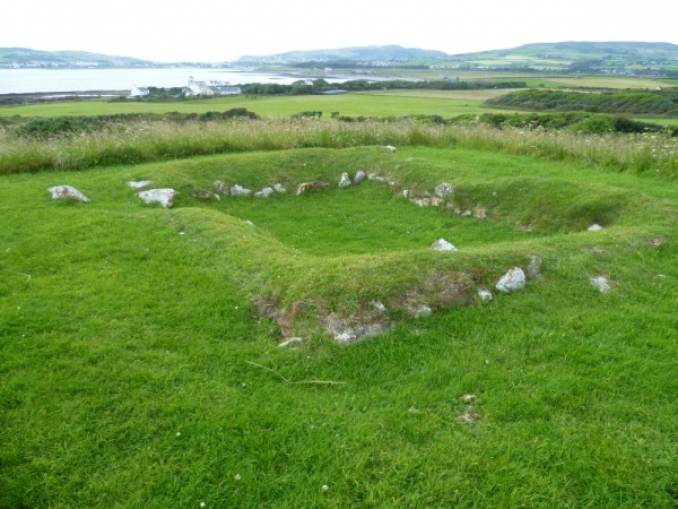Balladoole

Balladoole is clearly a remarkable historical and archaeological site. The hilltop overlooking the coast at Bay ny Carrickey southeast of Port St Mary, Isle of Man (Manx: Purt le Moirrey, Mannin) has been used for millennia as a place of ritual. Excavations of the hilltop have uncovered Mesolithic remains; a Bronze Age cist; an Iron Age hill fort; a Christian keeill ( small chapel); a Christian burial ground, and a Viking Age boat burial.
The Mesolithic remains or (middle stone age) are thought to date to period between, 8000 BC- 4000 BC. Human activity from this time has been revealed at Balladoole by midden objects found belonging to the native hunter-gather communities.
The Mesolithic remains or (middle stone age) are thought to date to period between, 8000 BC- 4000 BC. Human activity from this time has been revealed at Balladoole by midden objects found belonging to the native hunter-gather communities.
Bronze Age remnants of a small burial cist dating to c.1000 BC are on the north side of the site. Also fragments of a Bronze Age cremation urn have been discovered below the floor of the later Christian keeill.
Iron Age Promontory Hillfort. Surrounding the Balladoole site are earthwork remains of the promontory hillfort. The Iron Age in the Isle of Man spans a period of about 500 BC–AD 400. Surviving original stone points to this defensive circle as possibly standing to a height of about 10 feet (3 metres) in places.
Keeill Vael. A number of Keeills (small chapels) built between the 6th and 12th can be found on the Isle of Man. The one at Balladoole has been dated to between 900 AD and 1000 AD. There was also an early Medieval (5th to the 11th centuries) Christian burial ground on the site with seventeen stone lined lintel graves excavated in the 1940's
.Viking Boat Burial. Dating back to between 850AD and 950AD, a Viking boat was excavated in 1945 by German archaeologist Gerhard Bersu, who was interned on the Isle of Man during World War II. The boat measuring 36 feet (11 metres) was buried directly on top of and into older Christian graves. This pagan burial had a number of items. Contained within the boat was a man, maybe a chieftain, certainly someone of high social standing. The remains of another corpse was found. A number of grave goods were also excavated from the Viking boat burial at Balladoole. These included a shield; a bronze ring-headed pin and a gilded belt buckle; Iron knives, a flint for striking flame, and an iron cauldron; items of riding equipment, including a bridle, stirrups and spurs with ornamental buckles. Many of these can be seen at the Manx Museum (Manx: Thie Tashtee Vannin).
Getting there
- By car - On the A5 between Castletown and Port St. Mary. Take the side road off the A5 towards Balladoole. This narrow road is to the right past the turning for the A28 Ballabeg Road.
- By bus - Routes no. 1, 1C, 2, and 2C stop along the A5 running from Douglas, Port St. Mary, and Port Erin. The stop is shortly after leaving Castletown. From the stop a short walk of about half a mile.
- By rail - Take the Steam Railway to Castletown. There is about a mile and a half walk from the rail station to the site or take the no. 1, 1C, 2 or 2C towards Port Erin from the main road near the station.
Celtic nation:
- Isle of Man
Itinerary:
- Isle of Man - southwest of island
Place type:
- Ancient site










